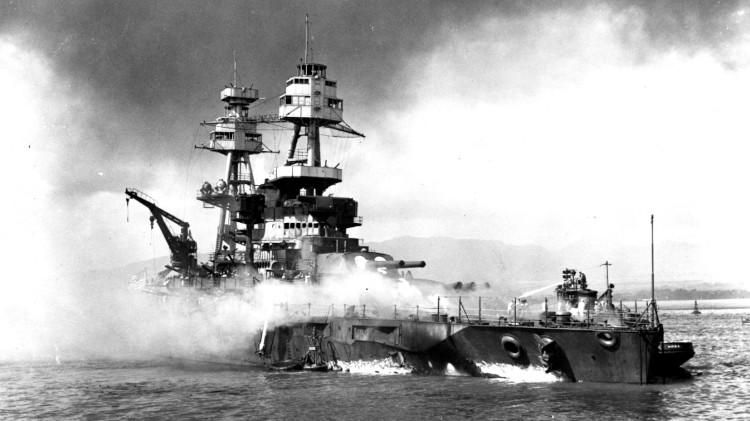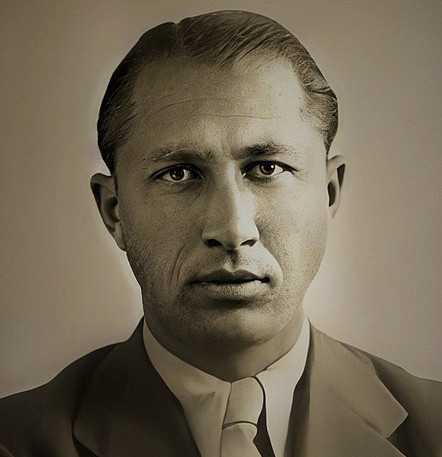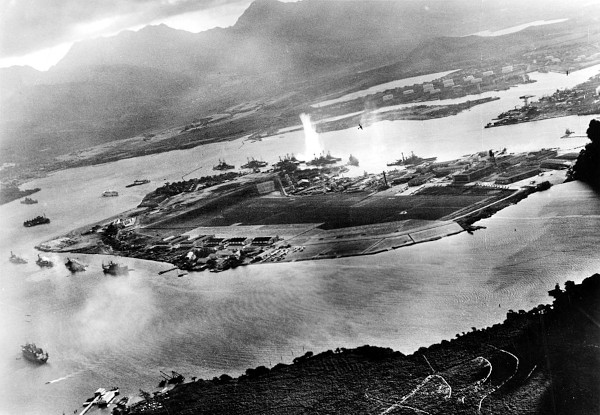
To mark the anniversary of the bombing of Pearl Harbor in 1941, Alan Bardos explains how uncovering a tale of spies helped him link Britain’s attack on Taranto in 1940 to the Japanese strike – and inspired his new novel, Rising Tide.
I have always been captivated by the daring and skill of the Fleet Air Arm‘s attack on the Italian fleet at Taranto in 1940 and the much larger airstrike on Pearl Harbor carried out by the Japanese Navy which brought the USA into the Second World War.
On the night of 11 November, 1940, the Fleet Air Arm attacked Italy’s principal naval base at Taranto with 21 obsolete Fairey Swordfish biplanes, launched from the aircraft carrier HMS Illustrious. They flew through an intense barrage to sink three battleships for the loss of two aircraft.

A year later the Japanese attacked Pearl Harbor, the major American naval base in the Pacific, on the morning of 7 December, 1941, with 350 modern aircraft launched from six aircraft carriers. They caught the US Fleet in the most infamous surprise attack in history and sank eight battleships for the loss of 21 aircraft.
The Taranto raid helped change the balance of power in the Mediterranean war, but has been overshadowed by Pearl Harbor. However, Taranto was the first time carrier launched aircraft were used to attack enemy ships in a heavily defended harbour. Although it did not inspire the Japanese attack on Pearl Harbor, it proved to them that it could be done.
These were pioneering battles that altered the course of the war and I have always wanted to write a novel that connected the two. The problem was how, when they were unrelated events, carried out thousands of miles apart.
The spark for my novel Rising Tide came when I discovered that Dusko Popov, a Yugoslavian national and a key British double agent, not only linked both events but also tried to warn the Americans of the coming attack.
Popov had originally been recruited by the Abwehr (German intelligence) to run agents in Britain. They set him up with an import export business in Lisbon, which allowed him to travel between Britain and Portugal. Popov switched allegiance as soon as he arrived in Britain.
MI5 recruited Popov into their Double–Cross System, which ‘turned’ German agents and used them to feed false information back to their handlers. Popov would travel to London to collect fake intelligence from his British handlers. He then travelled back to Lisbon to deliver this intelligence to his German handlers.
It was on one of these trips to Lisbon that Popov met up with his friend Johnny Jebsen, an Abwehr officer. Jebsen told Popov that he had accompanied a delegation from the Japanese Imperial Navy around the scene of the Taranto attack. They had very specific questions about the methods used by the attacking aircraft and the damage inflicted during the attack. They both agreed this indicated that the Japanese were planning a similar attack; they just didn’t know where.
In August 1941 Popov’s German handlers sent him to America to establish contact with their agents operating in America and to set up a new network. He was given a list of questions about America to answer.
A third of the questionnaire concerned Pearl Harbor and Hawaii. It included questions about the layout of its airfields, naval defences, ammunition dumps and anti-torpedo nets.
This suggests it was part of a growing cooperation between German and Japanese Intelligence. The two services exchanged information and Germany hoped that a war between Japan and the USA would keep America occupied in the Far East, and out of European affairs. This forms the principal storyline of my novel.
Popov believed that Jebsen’s information and the questionnaire both indicated that the Japanese were planning a Taranto style raid on Pearl Harbor. His handlers in MI5 agreed and arranged for Popov to meet with the FBI when he reached New York. In Rising Tide, my lead character, Daniel Nichols, is wounded during the raid on Taranto and joins Naval Intelligence. He then follows in Dusko Popov’s real-life footsteps.
In Popov’s words, he was met by the FBI Director J Edgar Hoover, “looking like a sledgehammer in search of an anvil”. The deeply conservative Hoover distrusted the flamboyant, womanising Popov and dismissed his warning. Instead Hoover tried to use Popov to lure out German agents, which would have broken his cover as a double agent.
The FBI doubted the authenticity of the questionnaire, believing it indicated too clearly that Pearl Harbor would be the target of an attack, and possibly thought it part of a British plan to entangle the USA in the war.
The questionnaire had been given to Popov in microdot form, a new technology that could reduce its pages to the size of a full stop. Hoover and his deputies showed more interest in this technology than the information it contained.
Popov was never allowed to travel onto Hawaii and attempt to establish contact with German spies there. Denied the opportunity to gather further evidence of a possible attack, he eventually returned to Europe and went onto play a significant role in Operation Fortitude, the Allied deception plan that paved the way for D-day.
Hoover could be forgiven for seeing Popov’s warning as tenuous, but he’d also received another warning of Japan’s interest in Hawaii from British intelligence.
At the beginning of 1941, British censors intercepted clandestine reports sent from New York to Europe via Bermuda. This led to the exposing of the ‘Joe K’ spy ring. Its discovery brought to light that the Abwehr had been gathering information on Pearl Harbor’s defences. It was still an ongoing case, which Hoover was personally overseeing, when he met with Dusko Popov.
He does not seem to have connected Popov’s warning with the Joe K spy ring, which corroborated Popov’s story, or at least showed it was worth further investigation.
But that is not the end of my story. After being rebuffed by Hoover, Nichols takes matters into his own hands and goes onto Hawaii. He discovers a conspiracy that threatens to keep America tied up in the Pacific and out of the war in Europe for years.
Rising Tide by Alan Bardos is available now as an ebook.
Read more about this book.
It’s the first in a new World War II series that follows Daniel Nichols as he moves from the Fleet Air Arm to Intelligence and Special Operations.
Writing historical fiction combines the first great love of Alan Bardos’s life, making up stories, with the second, researching historical events and characters. He currently lives in Oxfordshire with his wife… the other great love of his life.
He has also written a First World War series featuring Johnny Swift, a disgraced and degenerate diplomat and soldier.
Find Alan at:
Twitter/X
Facebook
Instagram
Goodreads
You may enjoy these related Historia features:
John F Kennedy, the ambassador’s second son by Susan Ronald
Family memories of Italy in World War Two by Cristina Loggia
Mussolini meets the World’s Fair by Anika Scott
Sent away by sea: the forgotten history of WWII’s ‘seaevacuees’ by Hazel Gaynor
Don’t mention the war! by Keith Lowe
Historia interviews: 2021 Non-fiction Crown Award winner Alan Allport by Frances Owen
Images:
- USS Nevada (BB-36) beached and burning after being hit forward by Japanese bombs and torpedoes: US National Archives (public domain)
- RNHF Swordfish LS326, Shoreham Airshow, 2013: Shoreham Airshow via Wikimedia (CC BY 2.0)
- Dusko Popov in 1941: Imperial War Museum via Wikimedia (public domain)
- Attack on Pearl Harbor, photo taken from a Japanese plane (a torpedo has just hit USS West Virginia): © United States Department of Defense via Wikimedia
- J Edgar Hoover, 5 April, 1940: Harris & Ewing collection, Library of Congress, via Wikimedia (no known copyright restrictions)








